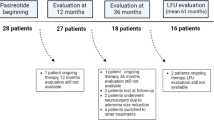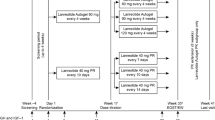Abstract
Purpose
Long-acting somatostatin analogs are one of the main classes of medical therapy used for acromegaly and most patients require ongoing treatment. Few studies have evaluated the long-term efficacy and safety of lanreotide depot beyond 2 years. The goal of this study was to provide a long-term longitudinal assessment of efficacy and safety of lanreotide depot in lanreotide responders compared to a surgically cured control group.
Methods
In this retrospective longitudinal case-control study, patients with acromegaly receiving lanreotide depot monotherapy continuously for at least 24 months (N = 24) and surgically cured patients (N = 39) were compared. Serum IGF-1, pituitary MRIs, lanreotide dose, co-morbidities and adverse effects were assessed longitudinally.
Results
In the lanreotide group, IGF-1 remained normal and unchanged over 6 years; comparable to the surgery only group. There was no difference in prevalence of normal IGF-1 between the lanreotide and surgery only groups at 6 months (100 vs. 97 %), 6 years (89 vs. 90 %) and at last follow-up (96 vs. 92 %). Tumor size remained stable (79 %) or decreased (21 %) in the lanreotide group. In the surgery only group, tumor size remained unchanged in all patients. Hemoglobin A1C did not differ between lanreotide and surgery only groups (baseline 5.8 vs. 6.1 %; last follow-up 6.0 vs. 5.7 %). Two (8 %) of the lanreotide and none of the surgery only group developed new diabetes mellitus.
Conclusion
Lanreotide depot maintains normalization of IGF-1 in 89 % of responders after 6 years, comparable to surgically cured controls, and controlled tumor size in all without significant adverse effects.



Similar content being viewed by others
References
Katznelson L, Laws ER, Melmed S et al (2014) Acromegaly: an endocrine society clinical practice guideline. J Clin Endocrinol Metab 99:3933–3951. doi:10.1210/jc.2014-2700
Howlett TA, Willis D, Walker G et al (2013) Control of growth hormone and IGF1 in patients with acromegaly in the UK: responses to medical treatment with somatostatin analogues and dopamine agonists. Clin Endocrinol (Oxf) 79:689–699. doi:10.1111/cen.12207
Colao A, Bronstein MD, Freda P et al (2014) Pasireotide versus octreotide in acromegaly: a head-to-head superiority study. J Clin Endocrinol Metab 99:791–799. doi:10.1210/jc.2013-2480
Tutuncu Y, Berker D, Isik S et al (2012) Comparison of octreotide LAR and lanreotide autogel as post-operative medical treatment in acromegaly. Pituitary 15:398–404. doi:10.1007/s11102-011-0335-y
Colao A, Pivonello R, Rosato F et al (2006) First-line octreotide-LAR therapy induces tumour shrinkage and controls hormone excess in patients with acromegaly: results from an open, prospective, multicentre trial. Clin Endocrinol (Oxf) 64:342–351. doi:10.1111/j.1365-2265.2006.02467.x
Grottoli S, Celleno R, Gasco V et al (2005) Efficacy and safety of 48 weeks of treatment with octreotide LAR in newly diagnosed acromegalic patients with macroadenomas: an open-label, multicenter, non-comparative study. J Endocrinol Invest 28:978–983
Cozzi R, Montini M, Attanasio R et al (2006) Primary treatment of acromegaly with octreotide LAR: a long-term (up to 9 years) prospective study of its efficacy in the control of disease activity and tumor shrinkage. J Clin Endocrinol Metab 91:1397–1403. doi:10.1210/jc.2005-2347
Ayuk J, Stewart SE, Stewart PM, Sheppard MC (2004) Efficacy of Sandostatin® LAR® (long-acting somatostatin analogue) is similar in patients with untreated acromegaly and in those previously treated with surgery and/or radiotherapy. Clin Endocrinol (Oxf) 60:375–381. doi:10.1111/j.1365-2265.2004.01992.x
Cozzi R, Attanasio R, Montini M et al (2003) 4-year treatment with octreotide-long-acting repeatable in 110 acromegalic patients: predictive value of short-term results? J Clin Endocrinol Metab 88:3090–3098. doi:10.1210/jc.2003-030110
Colao A, Ferone D, Marzullo P et al (2001) Long-term effects of depot long-acting somatostatin analog octreotide on hormone levels and tumor mass in acromegaly. J Clin Endocrinol Metab 86:2779–2786. doi:10.1210/jc.86.6.2779
Lancranjan I, Atkinson AB (1999) Results of a European multicentre study with Sandostatin LAR in acromegalic patients, 1st edn. Sandostatin LAR Group, Pituitary, pp 105–114
Ben-Shlomo A, Melmed S (2010) Pituitary somatostatin receptor signaling. Trends Endocrinol Metab 21:123–133. doi:10.1016/j.tem.2009.12.003
Ben-Shlomo A, Melmed S (2008) Somatostatin agonists for treatment of acromegaly. Mol Cell Endocrinol 286:192–198. doi:10.1016/j.mce.2007.11.024
Alexopoulou O, Abrams P, Verhelst J et al (2004) Efficacy and tolerability of lanreotide Autogel therapy in acromegalic patients previously treated with octreotide LAR. Eur J Endocrinol 151:317–324. doi:10.1530/eje.0.1510317
Van Thiel SW, Romijn JA, Biermasz NR et al (2004) Octreotide long-acting repeatable and lanreotide Autogel are equally effective in controlling growth hormone secretion in acromegalic patients. Eur J Endocrinol 150:489–495. doi:10.1530/eje.0.1500489
Flogstad AK, Halse J, Bakke S et al (1997) Sandostatin LAR in acromegalic patients: long-term treatment. J Clin Endocrinol Metab 82:23–28
Stewart PM, Kane KF, Stewart SE et al (1995) Depot long-acting somatostatin analog (sandostatin-LAR) is an effective treatment for acromegaly. J Clin Endocrinol Metab 80:3267–3272. doi:10.1210/jc.80.11.3267
Ayuk J, Stewart SE, Stewart PM, Sheppard MC (2002) Long-term safety and efficacy of depot long-acting somatostatin analogs for the treatment of acromegaly. J Clin Endocrinol Metab 87:4142–4146. doi:10.1210/jc.2001-011913
Colao A, Auriemma RS, Galdiero M et al (2009) Effects of initial therapy for 5 years with somatostatin analogs for acromegaly on growth hormone and insulin-like growth factor-i levels, tumor shrinkage, and cardiovascular disease: a prospective study. J Clin Endocrinol Metab 94:3746–3756. doi:10.1210/jc.2009-0941
Caron P, Cogne M, Raingeard I et al (2006) Effectiveness and tolerability of 3-year lanreotide Autogel® treatment in patients with acromegaly. Clin Endocrinol (Oxf) 64:209–214. doi:10.1111/j.1365-2265.2006.02450.x
Maiza JC, Vezzosi D, Matta M et al (2007) Long-term (up to 18 years) effects on GH/IGF-1 hypersecretion and tumour size of primary somatostatin analogue (SSTa) therapy in patients with GH-secreting pituitary adenoma responsive to SSTa. Clin Endocrinol (Oxf) 67:282–289. doi:10.1111/j.1365-2265.2007.02878.x
Gutt B, Bidlingmaier M, Kretschmar K et al (2005) 4-year follow-up of acromegalic patients treated with the new long-acting formulation of lanreotide (lanreotide autogel). Exp Clin Endocrinol Diabetes 113:139–144. doi:10.1055/s-2005-837520
Itoh S, Tanaka K, Kumagae M, Takeda F, Morio K, Kogure M, Hasegawa M, Horiuchi T, Watabe T, Miyabe S et al (1988) Effect of subcutaneous injection of a long-acting analogue of somatostatin (SMS 201-995) on plasma thyroid-stimulating hormone in normal human subjects. Life Sci 42:2691–2699
Cuttica CM, Fazzuoli L, Cariola G et al (1994) Behavior of the pituitary-thyroid axis in acromegalic subjects during prolonged intermittent and pulsatile treatment with octreotide. Recent Prog Med 85:7–12
Colao A, Auriemma RS, Pivonello R et al (2015) Interpreting biochemical control response rates with first-generation somatostatin analogues in acromegaly. Pituitary. doi:10.1007/s11102-015-0684-z
Carmichael JD, Bonert VS, Nuño M et al (2014) Acromegaly clinical trial methodology impact on reported biochemical efficacy rates of somatostatin receptor ligand treatments: a meta-analysis. J Clin Endocrinol Metab 99:1825–1833. doi:10.1210/jc.2013-3757
Attanasio R, Barausse M, Cozzi R (2001) GH/IGF-I normalization and tumor shrinkage during long-term treatment of acromegaly by lanreotide. J Endocrinol Invest 24:209–216. doi:10.1007/BF03343849
Karavitaki N, Turner HE, Adams CBT et al (2008) Surgical debulking of pituitary macroadenomas causing acromegaly improves control by lanreotide. Clin Endocrinol (Oxf) 68:970–975. doi:10.1111/j.1365-2265.2007.03139.x
Carmichael JD, Bonert VS, Mirocha JM, Melmed S (2009) The utility of oral glucose tolerance testing for diagnosis and assessment of treatment outcomes in 166 patients with acromegaly. J Clin Endocrinol Metab 94:523–527. doi:10.1210/jc.2008-1371
Zeinalizadeh M, Habibi Z, Fernandez-Miranda JC et al (2015) Discordance between growth hormone and insulin-like growth factor-1 after pituitary surgery for acromegaly: a stepwise approach and management. Pituitary 18:48–59. doi:10.1007/s11102-014-0556-y
Matta M, Bongard V, Grunenwald S et al (2011) Clinical and metabolic characteristics of acromegalic patients with high IGF1/normal GH levels during somatostatin analog treatment. Eur J Endocrinol 164:885–889. doi:10.1530/EJE-11-0098
Lee CC, Vance ML, Xu Z et al (2014) Stereotactic radiosurgery for acromegaly. J Clin Endocrinol Metab 99:1273–1281. doi:10.1210/jc.2013-3743
Wattson DA, Tanguturi SK, Spiegel DY et al (2014) Outcomes of proton therapy for patients with functional pituitary adenomas. Int J Radiat Oncol Biol Phys 90:532–539
Petit JH, Biller BMK, Coen JJ et al (2007) Proton stereotactic radiosurgery in management of persistent acromegaly. Endocr Pract 13:726–734. doi:10.4158/EP.13.7.726
Strasburger CJ, Karavitaki N, Störmann S et al (2016) Patient-reported outcomes of parenteral somatostatin analogue injections in 195 patients with acromegaly. Eur J Endocrinol. doi:10.1530/EJE-15-1042
Paisley AN, Roberts ME, Trainer PJ (2007) Withdrawal of somatostatin analogue therapy in patients with acromegaly is associated with an increased risk of acute biliary problems. Clin Endocrinol (Oxf) 66:723–726. doi:10.1111/j.1365-2265.2007.02811.x
Salvatori R, Woodmansee WW, Molitch M et al (2014) Lanreotide extended-release aqueous-gel formulation, injected by patient, partner or healthcare provider in patients with acromegaly in the United States: 1-year data from the SODA registry. Pituitary 17:13–21. doi:10.1007/s11102-012-0460-2
Salvatori R, Nachtigall LB, Cook DM et al (2010) Effectiveness of self- or partner-administration of an extended-release aqueous-gel formulation of lanreotide in lanreotide-naïve patients with acromegaly. Pituitary 13:115–122. doi:10.1007/s11102-009-0207-x
Mazziotti G, Porcelli T, Bogazzi F et al (2011) Effects of high-dose octreotide lar on glucose metabolism in patients with acromegaly inadequately controlled by conventional somatostatin analog therapy. Eur J Endocrinol 164:341–347. doi:10.1530/EJE-10-0811
Couture E, Bongard V, Maiza JC et al (2012) Glucose status in patients with acromegaly receiving primary treatment with the somatostatin analog lanreotide. Pituitary 15:518–525. doi:10.1007/s11102-011-0361-9
Colao A, Auriemma RS, Savastano S et al (2009) Glucose tolerance and somatostatin analog treatment in acromegaly: a 12-month study. J Clin Endocrinol Metab 94:2907–2914. doi:10.1210/jc.2008-2627
Acknowledgments
This study was supported by an investigator-initiated grant from Ipsen.
Author information
Authors and Affiliations
Corresponding author
Ethics declarations
Conflict of interest
The authors declare they have no conflict of interest to report.
Rights and permissions
About this article
Cite this article
Sagvand, B.T., Khairi, S., Haghshenas, A. et al. Monotherapy with lanreotide depot for acromegaly: long-term clinical experience in a pituitary center. Pituitary 19, 437–447 (2016). https://doi.org/10.1007/s11102-016-0724-3
Published:
Issue Date:
DOI: https://doi.org/10.1007/s11102-016-0724-3




